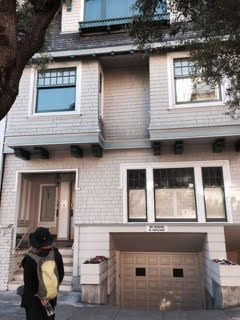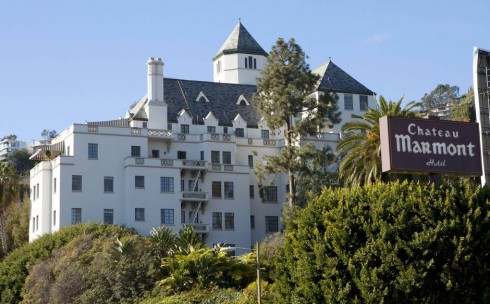The Story Of That Marvelous Hero
Dalton Trumbo
By LIONEL ROLFE
A few days ago, Judith Aller, a prominent concert violinist and conductor in Europe and America, wrote me a note saying that her now dead husband’s film about screenwriter Dalton Trumbo was going to be premiered–and asked me if I wanted to go.
I had known Bruce Cook before I knew her, and they did meet at a party at my house, as I remember. Bruce was a wonderful and grand fellow–he was book editor of the Los Angeles Daily News and he gave me lots of room to write for him there. He had also been book editor at USA Today and a senior editor at Newsweek. He even wrote a novel about a Latino private detective in East Los Angeles.
He married Aller in 1994. It’s no accident that he was particularly proud of having written one of the first books on American beatniks–The Beat Generation in 1971. And, I hate to mention it, I had once given a book of his about Bertolt Brecht a bad review in the LA Times–I hope he never saw that review, because he was an old fashioned gentleman who wrote with passion and caring about those who stood up to power. Read more
MAKING OUR OWN HISTORY AT THE CHATEAU MARMONT
By Bob Vickrey
Barry Stein is the only native Angelino in our monthly lunch group, and he prides himself on knowing every back road and alley in all of Southern California.
His job as driver commands such respect that other members of the group have been instructed to call him “The Driver” when he picks us up for our trips to some of the oldest and most famous restaurants in the city. He often reminds us to capitalize the “T” when designating his role as “The Driver.”
Barry is a photographer whose finished works are so secretive that few of his friends have ever seen his photos. Only employees of Pricewaterhouse, the accounting firm that protects the secrecy of the Oscar ballots each year, have allegedly seen his work. Read more
Book Review: The Last of the President’s Men
“The Last of the President’s Men”
by Bob Woodward
Simon & Schuster
by Doug Weiskopf
When Richard Nixon was forced to resign as president in 1974 after a House Committee voted for articles of impeachment and Nixon’s friend in the Senate, Barry Goldwater, informed him that he faced a certain vote of expulsion from office, people thought they knew the worst of the man. He had allowed a cabal of White House aides to become involved in a myriad of illegal activities against American citizens and then took part in a massively organized cover-up of their crimes. It was further learned through the Senate Watergate Committee that Nixon had for years engaged in a large scale secret bombing campaign in Southeast Asia, including Vietnam, Cambodia, and Laos.
This year, however, new damning information has come out against Nixon, showing him to be not only the ‘crook” he so famously denied he was, but also arguably was clinically insane, according to Alexander P. Butterfield, who worked in closer proximity to Nixon than anyone for most of his presidency and ended up providing the fatal testimony to the Watergate Committee of the existence of the Oval Office taping system that ultimately brought Nixon down. In Bob Woodward’s new book, “The Last of the President’s Men” Butterfield’s life story and how he came to be Nixon’s chief office aid is examined.
Earlier this year we had already been given a glimpse into the mental pathology of Nixon from the HBO broadcast, “Nixon By Nixon: In His Own Words”, where newly released White House recordings taped between 1971 and 1973 were played, revealing Nixon as sounding quite paranoid and easily enraged at all whom he considered his mortal “enemies” (remember, he even compiled a secret “enemies list” of all those he believed were out to get him). Woodward’s latest book gives greater context to how Nixon became increasingly crazy-acting and affected all those around him to become corrupted, to the point where when what they did to serve their Commander In Chief came to light they ended up serving prison sentences. Read more
VAN ALLSBURG’S CLASSIC ‘THE POLAR EXPRESS’ TURNS THIRTY
By Bob Vickrey
When I was a young boy growing up in the suburbs of southeast Houston, every Christmas Eve I would sneak out onto our screened front porch and stare into the night sky as I tried to spot Santa’s sleigh as it arrived from the North Pole.
In our community of Galena Park, the bright lights of the refineries that lined the banks of the Houston Ship Channel lit the sky each night, so it did not require much imagination for a restless boy to envision Santa’s sparkling red sleigh and reindeer moving swiftly across the horizon amid all those flickering lights.
Many years later as an adult, I worked in the book business for the venerable Boston firm Houghton Mifflin, which published Chris Van Allsburg’s landmark Christmas classic, “The Polar Express.” Read more
City Takes Some Steps to Confront Homeless Crisis
Leslie Evans
Five months after the Los Angeles city government began to debate new ordinances to confront our deepening homeless calamity, the City Council on November 18 announced its first steps. The L.A. Times in an editorial the next day declared the effort “a start, even if some of the measures are anemic.”
In September the Council had promised to raise $100 million to abate homelessness in the city. The county supervisors pledged their own $100 million fund. As of the November 18 announcements the kitty contained only $16 million. Specific proposals were to set aside vacant city buildings as winter shelters and to seek out parking lots where people living in cars and RVs could camp at night, possibly with porta potties supplied by the city. These are promising beginnings, but Council members pointed out that many bureaucratic hurdles stood in the way of assigning buildings to such uses and nothing was likely to happen until the new year. One L.A. Times report suggested that the parking lots under consideration were those of churches and not city property. Read more
Hudson Bell of Fern Hill takes Honey on an historic walk through San Francisco
NOTES FROM ABOVE GROUND
By Honey van Blossom
(Honey is a Belgian Marxist former strip-tease artiste)
 Ina’s_house is by Feride B. Diri, showing Honey looking at Ina Coolbrith’s house on Broadway
Ina’s_house is by Feride B. Diri, showing Honey looking at Ina Coolbrith’s house on Broadway
Juan Bautista de Anza sited the fort called El Presidio Real de San Francisco on March 28, 1776. A year later, Jose Joaquin Moraga built the garrison, numbering 33 men. By 1825, the Presidio had 120 houses and perhaps 500 people, mostly women and children. The Mexican government recognized the Presidio as a pueblo in 1834. According to W. W. Robinson, relying on attorney John Whipple Dwinelle’s argument in the United States District Court case titled The City of San Francisco v. The United States (published as a book in 1863) by 1835 “ the population was shifting from the table land above the sea to the sheltered cove adjacent to Telegraph Hill where the table land above the sea to the sheltered cove adjacent to Telegraph Hill where the village of Yerba Buena was being born…. Until 1846 alcaldes and justices of the peace in Yerba Buena granted town lots to its inhabitants, the first conveyance being to William A. Richardson on June 2, 1836, of a 100-vara lot in the northwest corner of Grant Avenue and Washington Street.” For a year Richardson — a naturalized Mexican citizen — lived in a canvas tent, and then he built a house.
In 1846 a couple of hundred people inhabited the village of Yerba Buena. “Yerba Buena” is the Spanish name for a number of aromatic plants, most of which belong to the mint family. The plant grew in abundance adjacent to the Mission San Francisco de Asis, founded by Moraga and Father Francisco Palou in 1776. Read more







